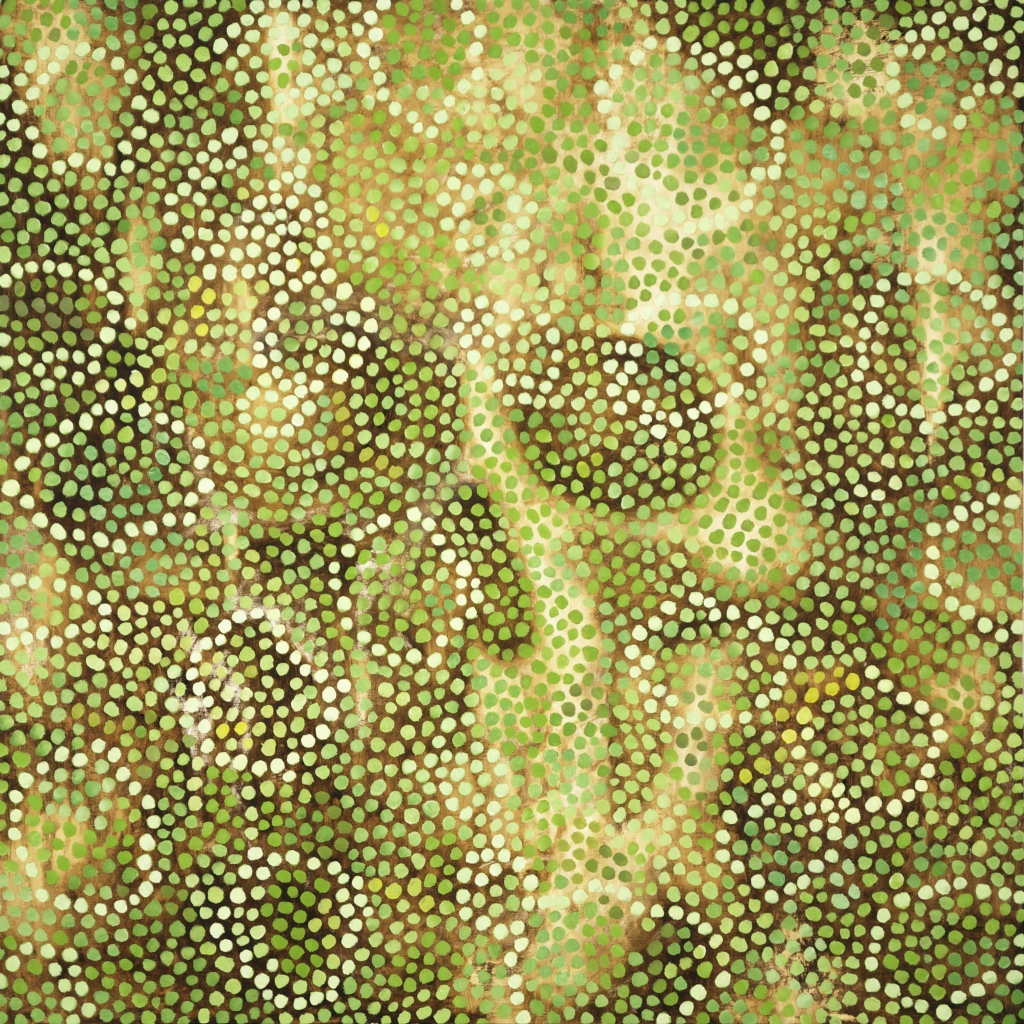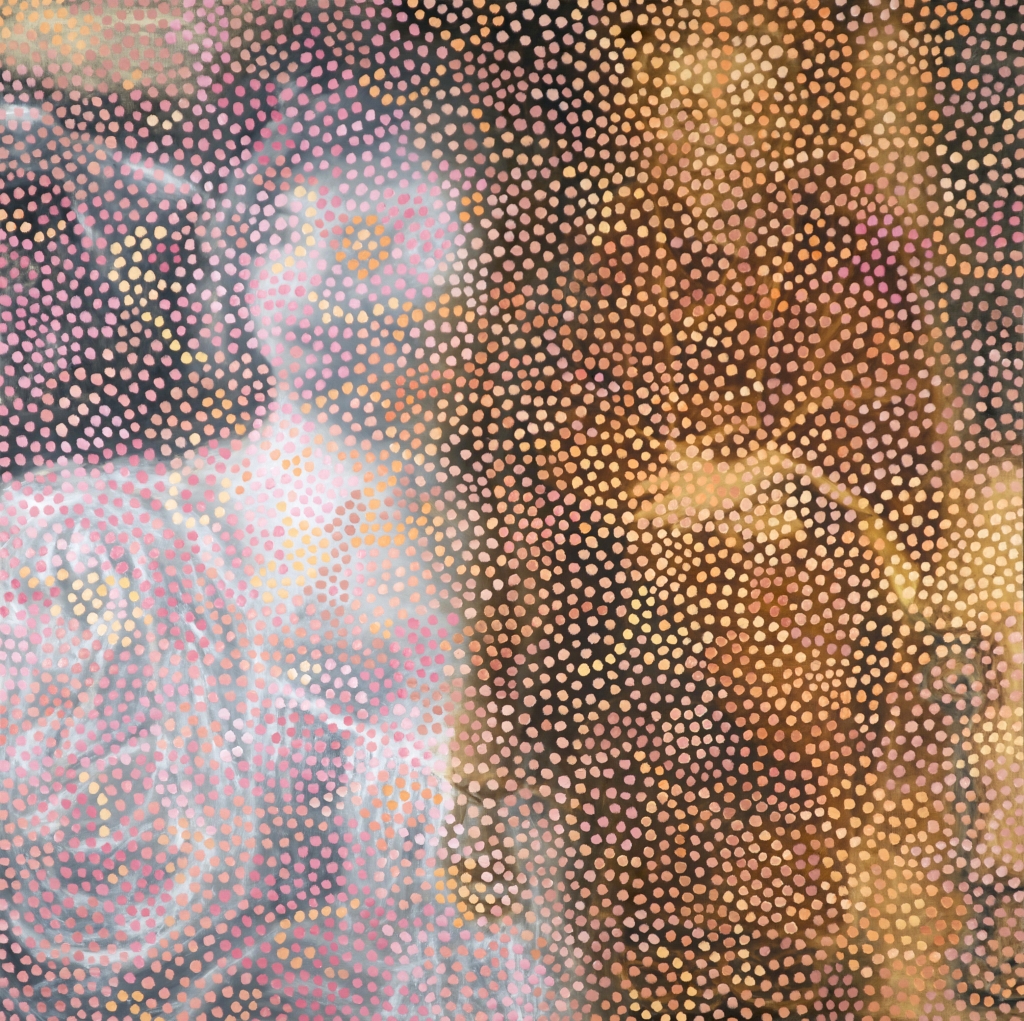絵画のなかのあらゆる人物は亡霊である。それは死者の像である。
なぜ絵画がそこに亡霊を呼び込むことになるのだろうか?
なぜそこに死者が出現するのだろうか?
夢幻能において、亡者は橋懸かりをへて能舞台に出現する。橋懸かりとは言うまでもなく、この現実とあの世との境にあるものだが、絵画の構造もこの橋懸かり的な意味を持つ。
木枠とキャンバス・・・白い下地が塗られた表面は、この現実が続く境目の位置にあり、そこから先、キャンバスの向こう側は誰も知ることはできない。それはあたかも橋懸かりのはじめにある揚幕のような存在で、死者の霊を待ち望んでいる。
そして絵を描く者はキャンバスとこの世界のあわい、皮膜に棲んでいる。皮膜が揺さぶられるとき、つまり絵筆によってキャンバスの表面が揺れるとき、そこに亡霊が出現する。それはほんのかすかな鼓動であり、能の謡の声には比べるまでもないが、確かにその声の始まりによって亡霊がそこに導かれる。そのとき、一瞬にして向こうとこちらの世界がつながったかのように感じられるがそれは幻想にすぎない。
絵画の世界には舞台はなく橋懸かりしかないのだ。一見あるように見えるそのこと(舞台、あるいはイリュージョン)、これは絵画にいつもついてまわるものではあるが実在するものではない。それは想像的なものである。
ここで重要なのは招来である。橋懸かりとは亡霊を招き呼び込むところに他ならない。あたかもそれは、初期の写真にあって今はもう写真では難しくなったもののごとく、ある時間とともにそこに浮かび上がってくるものなのだ。それがこの働きである。それは時間を凝縮することによって起こる。
初期の写真では、現代のように一瞬にして見ているもの(被写体)を写し取ることはできないし、絵もまた一瞬では完成しない。被写体となったもの、あるいは絵の対象者はそこにじっとしていなければならない。その時間こそが亡霊の出現に欠かせない時間であり、亡霊とは凝縮された時間の現れ、もしくはその移動に他ならない。それは死んだ一瞬ではなく動いている。それを空間的に表すとなると橋懸かりの場となる。亡霊の招来には時間がかかるのだ。
だから、私はやはり舞台を見たいわけではないのだ。ギリシア悲劇のようにコロスによってそこに劇的なるものが出現することを望んでいるわけではない。私の願いはささやかな霊媒者の望みであって、劇的なるものを待ち望んでいる観客のそれではない。
その印として私はここにいることを刻印する。点を打つ。この皮膜に棲んでいることを
刻印しながら絵を終息に向かわせる。
「ALL HUMAN FIGURES THAT APPEAR IN PAINTINGS ARE GHOSTS」
All human figures that appear in paintings are ghosts. They are images of the dead.
Why is it that paintings invite such spirits? Why is it that the deceased appear within the picture frame?
In Mugen Noh (fantasy Noh), the dead appear on stage as they cross the hashigakari *1. Needless to say, the hashigakari lies on the border between reality and the spirit world, but the structure of paintings also takes on a similar significance.
A wooden frame and canvas… The white ground of the prepared surface occupies the borderline between ensuing reality, but no one can know what lies beyond it on the other side of the canvas. It has a similar existence, so to speak, as the agemaku*2 at the beginning of the hashigakari, waiting in anticipation of the spirits of the dead.
At the same time, the person painting the picture inhabits a layer of film stretched between the canvas and this world. It is when this layer is jolted, that is to say when the surface of the canvas undulates at the touch of the paintbrush, that ghosts emerge. It is only the faintest pulsation, and nothing comparable to the chanting voices in Noh, but it is undoubtedly this first “utterance” that invokes the spirits. When this happens, for a short instant there is a sense that the real world and that of the spirits appear connected, yet this is nothing more than an illusion.
In the world of painting there is no stage, only a bridge. Seemingly visible at first glance, this “stage” or “illusion” always attaches itself to painting but does not in fact exist. It is a figment of the imagination.
What is important here is that of “invitation”. The hashigakari is nothing more than a place where spirits are summoned. As with early photography, and now more difficult to achieve with modern photography, it is as if something rises to the surface together with the passing of time. That is the mechanism at play here, and it occurs as time with the compression of time.
In early photography, it wasn’t possible to reproduce the visible subject instantaneously as it is today, and by the same token paintings also cannot be completed in an instant. That which becomes the photographic subject, or that which becomes the object of the painting must remain still. This duration of time is indispensable in order for ghosts to appear, and their appearance is nothing more than the result of time condensed, or rather the result of their shifting through time. Their forms not only shift at the instance of death, but are in a perpetual state of motion. In making them visible in a spatial plain, they occupy the place of the hashigakari. It takes time to summon the spirits.
And so, after all it is not a stage that I want to see. I am not seeking the emergence of dramatic events as in Greek tragedy, brought about through the chorus. What I am hoping for is the modest desire of a medium, not that of an audience waiting in anticipation for the drama.
As a mark of my intention, I imprint my presence on the surface, dot after dot. As I imprint my existence inside this layer of film, I direct the painting towards its end.
Notes
(1) A bridge-like passageway connecting the back of the theater with the main stage.
(2) The entrance curtain between the back of the theater and the hashigakari.

